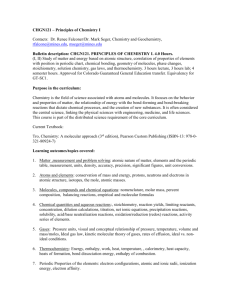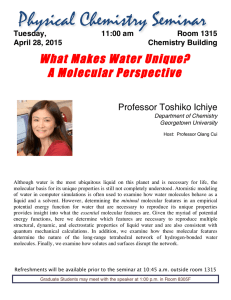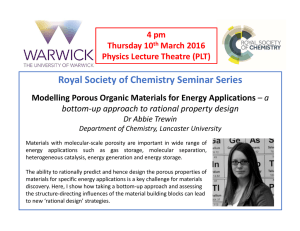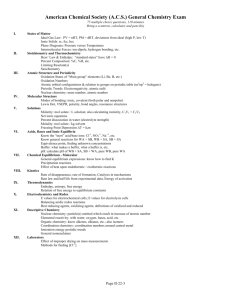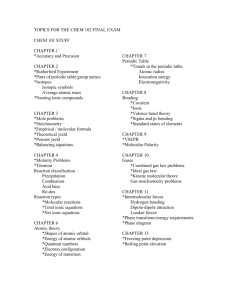College of San Mateo Official Course Outline COURSE ID: Semester Units/Hours:
advertisement
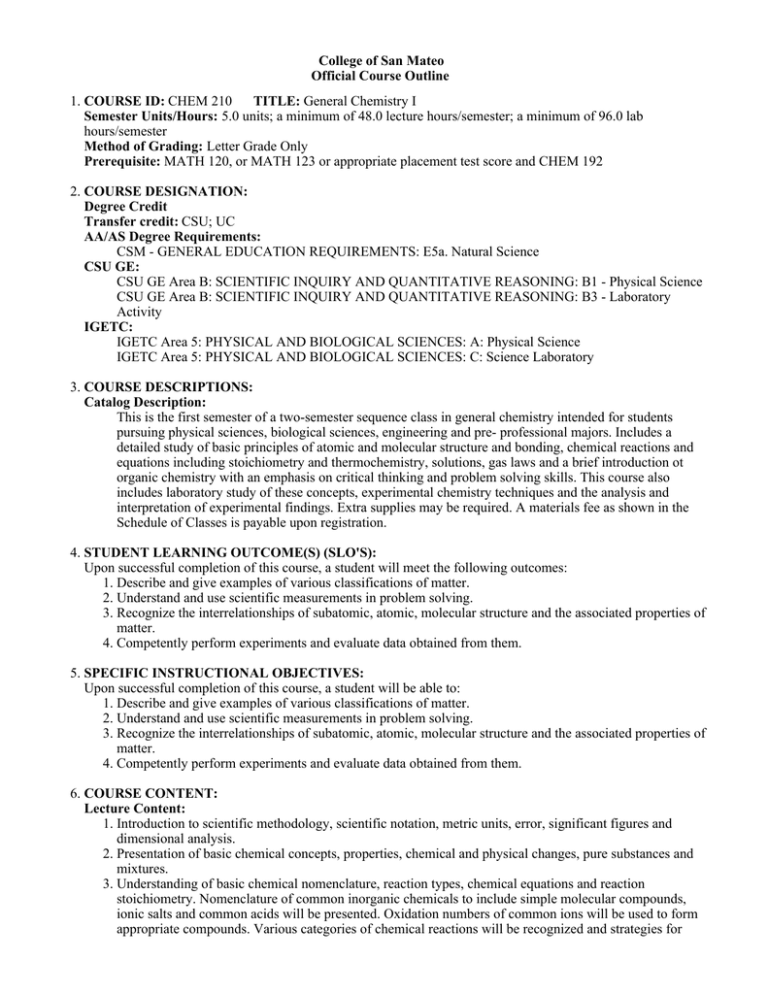
College of San Mateo Official Course Outline 1. COURSE ID: CHEM 210 TITLE: General Chemistry I Semester Units/Hours: 5.0 units; a minimum of 48.0 lecture hours/semester; a minimum of 96.0 lab hours/semester Method of Grading: Letter Grade Only Prerequisite: MATH 120, or MATH 123 or appropriate placement test score and CHEM 192 2. COURSE DESIGNATION: Degree Credit Transfer credit: CSU; UC AA/AS Degree Requirements: CSM - GENERAL EDUCATION REQUIREMENTS: E5a. Natural Science CSU GE: CSU GE Area B: SCIENTIFIC INQUIRY AND QUANTITATIVE REASONING: B1 - Physical Science CSU GE Area B: SCIENTIFIC INQUIRY AND QUANTITATIVE REASONING: B3 - Laboratory Activity IGETC: IGETC Area 5: PHYSICAL AND BIOLOGICAL SCIENCES: A: Physical Science IGETC Area 5: PHYSICAL AND BIOLOGICAL SCIENCES: C: Science Laboratory 3. COURSE DESCRIPTIONS: Catalog Description: This is the first semester of a two-semester sequence class in general chemistry intended for students pursuing physical sciences, biological sciences, engineering and pre- professional majors. Includes a detailed study of basic principles of atomic and molecular structure and bonding, chemical reactions and equations including stoichiometry and thermochemistry, solutions, gas laws and a brief introduction ot organic chemistry with an emphasis on critical thinking and problem solving skills. This course also includes laboratory study of these concepts, experimental chemistry techniques and the analysis and interpretation of experimental findings. Extra supplies may be required. A materials fee as shown in the Schedule of Classes is payable upon registration. 4. STUDENT LEARNING OUTCOME(S) (SLO'S): Upon successful completion of this course, a student will meet the following outcomes: 1. Describe and give examples of various classifications of matter. 2. Understand and use scientific measurements in problem solving. 3. Recognize the interrelationships of subatomic, atomic, molecular structure and the associated properties of matter. 4. Competently perform experiments and evaluate data obtained from them. 5. SPECIFIC INSTRUCTIONAL OBJECTIVES: Upon successful completion of this course, a student will be able to: 1. Describe and give examples of various classifications of matter. 2. Understand and use scientific measurements in problem solving. 3. Recognize the interrelationships of subatomic, atomic, molecular structure and the associated properties of matter. 4. Competently perform experiments and evaluate data obtained from them. 6. COURSE CONTENT: Lecture Content: 1. Introduction to scientific methodology, scientific notation, metric units, error, significant figures and dimensional analysis. 2. Presentation of basic chemical concepts, properties, chemical and physical changes, pure substances and mixtures. 3. Understanding of basic chemical nomenclature, reaction types, chemical equations and reaction stoichiometry. Nomenclature of common inorganic chemicals to include simple molecular compounds, ionic salts and common acids will be presented. Oxidation numbers of common ions will be used to form appropriate compounds. Various categories of chemical reactions will be recognized and strategies for balancing reaction equations will be learned. Simple redox concepts will be presented but redox equation balancing reaction equations will be learned. Simple redox concepts will be presented but redox equation balancing will be left for the second semester course. Students will learn the mole concept, formula and molecular mass calculations, percentage composition, empirical and molecular formula determinations. Students will apply these principles to calculate theoretical yields for reactions, recognize limiting reagents, and will understand percentage yields. 4. Introduction to atomic theory. The student will understand modern atomic theory will regard to the major subatomic particles. Basic properties of atoms, ions and isotopes will be understood with regard to mass, isotopes, nuclear composition and ion formation. Electronic structure will be explored particularly with regard to quantum theory, electron energy levels, atomic orbitals and their associated shapes. Students will have an understanding of electronic configurations and their relationships to the periodic table. The periodic table will be presented so that the element classifications, periodic law, characteristics of families, and periodic properties will be appreciated. 5. Chemical bonding and resulting chemical structures will be studied. Ionic versus covalent bonding will be understood with an appreciation of the resulting chemical behaviors. Students will learn how molecular shapes are determined and presented by using tools such as Lewis structures, formal charge and VSEPR theories. Various ideas will reinforce the appreciation of chemical structure such as atomic hybridization and resulting bond angles, polarization of molecules, electron pair distribution and overall molecular geometry. Intermolecular forces due to molecular polarity will be explored. Students will understand liquid and solid formation processes for molecular, ionic and metallic materials. 6. Students will explore the states of matter. Gas laws will be studied in depth for ideal behavior as determined by common gas laws such as Boyle's, Charles', Gay-Lussac's, Dalton's and Avogadro's. The ideal gas law and its common applications will be presented. Qualitative reasoning for gas law deviations will be presented and the kinetic molecular theory will be understood. The common properties of the liquid state will be presented along with the energy considerations for transitions between states. Solids will be studied for typical bonding attractions, phase change behavior and crystalline behavior. Students will understand basic phase diagrams and transitions between states. 7. Solution formation will be presented at both the atomic level (solvation processes) and the macro level in terms of solution concentrations and volumetric techniques. Basic solubility properties will be explored and colligative properties will be presented. Energetics of solution formation will be presented and students will understand ionic solution reactions and net ionic equations. 8. Energy of chemical reactions will be explored during a presentation of introductory thermo chemistry. The nature of enthalpy, bond energies, calorimetry and Hess's Law will be understood. 9. There will be a brief discussion of organic chemistry. Lab Content: 1. Statistical analysis of data. 2. Lab safety. 3. Chemical versus physical properties analysis through the separation of a mixture. 4. Density measurement and calculations. 5. Volumetric glassware. 6. Empirical formula determination. 7. Nomenclature. 8. Balancing equations. 9. Acid base titration to determine the molar mass of an unknown acid. 10. Net ionic equations. 11. Preparing solutions with both solid solutes and concentrated solutions. 12. Heat capacity of a metal. 13. Heat of fusion of ice. 14. Determination of heat content of several acid base neutralizations. 15. Hess's addition method. 16. Energy content of food. 17. Rydberg equation calculations. 18. Electron configurations. 19. Molecular structure including hybridization, orbital geometry, molecular geometry and polarity. 20. Intermolecular forces. 21. Properties of solutions. 22. Spectroscopic determination including a discussion a standard calibration curves. 23. Gas laws. 24. Molar mass of a volatile liquid. These are examples of possible laboratory exercises. Other exercises my be substituted but the topics covered will remain the same. 7. REPRESENTATIVE METHODS OF INSTRUCTION: Typical methods of instruction may include: A. Lecture B. Lab C. Other (Specify): Lecture style presentation of material. Video programs and computer programs. Games to challenge the student's comprehension of the material. A minimum of two in class exams and a comprehensive final. Six hours of laboratory per week. Group work on problems in lecture and experimental procedures in lab. Short quizzes in lecture and in lab. Homework assignments from the chapter questions and/ or handouts. Design a lab procedure and check to see if it works. 8. REPRESENTATIVE ASSIGNMENTS Representative assignments in this course may include, but are not limited to the following: Writing Assignments: Homework assignments from the chapter questions and/or handouts. Reading Assignments: Read the lab procedures before coming to lab. 9. REPRESENTATIVE METHODS OF EVALUATION Representative methods of evaluation may include: A. Exams/Tests B. Final Performance C. Homework D. Lab Activities E. Quizzes F. A minimum of two in class exams and a comprehensive final exam. Short quizzes in lecture and in lab. Laboratory experiment reports. Homework assignments from the chapter questions and/or handouts. 10. REPRESENTATIVE TEXT(S): Possible textbooks include: A. Tro.. Principles of Chemistry, ed. -, 2010 B. Silberberg, M.. Principles of General Chemistry, 3rd ed. Mc Graw-Hill, 2013 Other: A. Chem 210 lab manual Fall 2013 Origination Date: August 2010 Curriculum Committee Approval Date: January 2014 Effective Term: Fall 2014 Course Originator: Charlotte Deline

